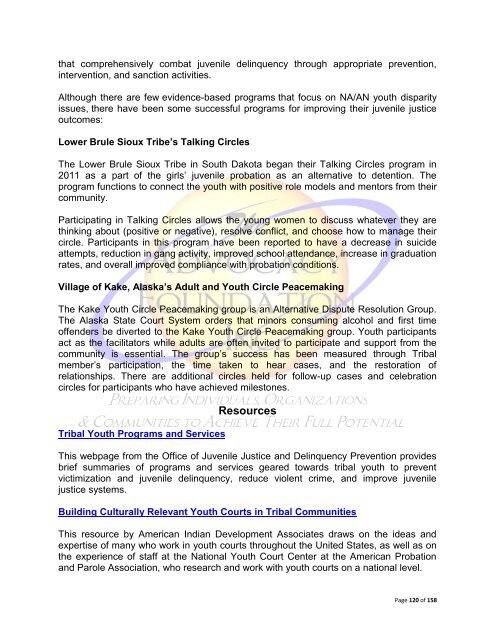Native American Youth In The Juvenile Justice System
Native American Youth In The Juvenile Justice System
Native American Youth In The Juvenile Justice System
You also want an ePaper? Increase the reach of your titles
YUMPU automatically turns print PDFs into web optimized ePapers that Google loves.
that comprehensively combat juvenile delinquency through appropriate prevention,<br />
intervention, and sanction activities.<br />
Although there are few evidence-based programs that focus on NA/AN youth disparity<br />
issues, there have been some successful programs for improving their juvenile justice<br />
outcomes:<br />
Lower Brule Sioux Tribe’s Talking Circles<br />
<strong>The</strong> Lower Brule Sioux Tribe in South Dakota began their Talking Circles program in<br />
2011 as a part of the girls’ juvenile probation as an alternative to detention. <strong>The</strong><br />
program functions to connect the youth with positive role models and mentors from their<br />
community.<br />
Participating in Talking Circles allows the young women to discuss whatever they are<br />
thinking about (positive or negative), resolve conflict, and choose how to manage their<br />
circle. Participants in this program have been reported to have a decrease in suicide<br />
attempts, reduction in gang activity, improved school attendance, increase in graduation<br />
rates, and overall improved compliance with probation conditions.<br />
Village of Kake, Alaska’s Adult and <strong>Youth</strong> Circle Peacemaking<br />
<strong>The</strong> Kake <strong>Youth</strong> Circle Peacemaking group is an Alternative Dispute Resolution Group.<br />
<strong>The</strong> Alaska State Court <strong>System</strong> orders that minors consuming alcohol and first time<br />
offenders be diverted to the Kake <strong>Youth</strong> Circle Peacemaking group. <strong>Youth</strong> participants<br />
act as the facilitators while adults are often invited to participate and support from the<br />
community is essential. <strong>The</strong> group’s success has been measured through Tribal<br />
member’s participation, the time taken to hear cases, and the restoration of<br />
relationships. <strong>The</strong>re are additional circles held for follow-up cases and celebration<br />
circles for participants who have achieved milestones.<br />
Tribal <strong>Youth</strong> Programs and Services<br />
Resources<br />
This webpage from the Office of <strong>Juvenile</strong> <strong>Justice</strong> and Delinquency Prevention provides<br />
brief summaries of programs and services geared towards tribal youth to prevent<br />
victimization and juvenile delinquency, reduce violent crime, and improve juvenile<br />
justice systems.<br />
Building Culturally Relevant <strong>Youth</strong> Courts in Tribal Communities<br />
This resource by <strong>American</strong> <strong>In</strong>dian Development Associates draws on the ideas and<br />
expertise of many who work in youth courts throughout the United States, as well as on<br />
the experience of staff at the National <strong>Youth</strong> Court Center at the <strong>American</strong> Probation<br />
and Parole Association, who research and work with youth courts on a national level.<br />
Page 120 of 158

















